Real Time
John Haberin New York City
Jorge Macchi, Joseph Zito, and Claudia Joskowicz
Janaye Brown, Simone Bailey, and Long Takes
Remember when art took time? It may seem strange on an evening in Chelsea, with people rushing everywhere in search of a gallery, a friend, an elevator, or a beer. Yet part of art's appeal is its demand for time—a demand to stop in one's tracks long enough to see it whole.
Jorge Macchi takes time, but not to step out of the present. Stick around, and he takes real time. A 2007 work of that title amounted to a digital clock, using matchsticks and not LEDs to tick off the minutes. Now he is no less immersed in the everyday. In a show filled with clocks, you may find yourself reaching for your watch. That way, you can start to experience the gallery in the present. 
In Macchi's XYZ, space is time. The title refers to the three coordinates of space and the room, corresponding to the three hands of a clock projected onto a corner. In another twenty seconds, it will be 4:00. This is not, however, a slide but a video that just happens not to change. A curved steel beam, resting between two white plastic foot stools, also marks both time and space. What looks like a sagging attempt at Minimalism follows the path of a pendulum.
For Joseph Zito, too, a clock does not tell time, because its three arms run backward, and it has no numbers anyway. Nor does an hourglass lying on its side, its white sand divided equally between its globes. Two others stand upright on a shelf, but their sands will never cross the narrows to deposit their black and deep red below. On video, Claudia Joskowicz, Janaye Brown, and Simone Bailey seem to capture a single moment, often a politically or culturally charged moment, by tracking both sides of the street or by holding the camera still. Instead of time, one has space—but a space that unfolds uncertainly in time. Are there lessons here for the chaos and spectacle of contemporary art?
Marking time
With Jorge Macchi, an electric fan does move—and it even emits a ticking sound as a blade collides with a cut that it only pretends to be making in the wall. If that means that the present moment is always fragile, other works use police tape, with ominous labels. If Macchi can grow flippant once he forgets the time, he has suffered from a reputation for conceptual art, including maps of imagined urban tours and heavily cut documents. Born in 1963, the Argentinean has had only one prior American solo exhibition as far as I know, "The Anatomy of Melancholy" at the Blanton Museum of Art in Austin, Texas, in 2008. The work seems anything but melancholy to me. Rather, the solidity of Minimalism is a welcome change.
Minimalism already insisted on real time, the time of one's passage through the gallery, as perhaps the prototype for "slow art." So did performance art, like Marina Abramovic walking the Great Wall of China, and so had drip painting by making the art object a record of its performance. So did Andy Warhol, with his shot of the Empire State Building, and so have any number of Warhol's heirs who distort real time—such T. J. Wilcox with daylight in Union Square, Douglas Gordon with 24-Hour Psycho, or James Nares with sixteen Manhattan rush hours compressed into one hypnotic hour of slow motion. So did contemporary music, and Macchi appeared in 2012 in a group show of artists influenced by John Cage. Good art does take time, but all these refuse the ideal of stepping outside time. They make art a page turner.
Macchi differs in depicting as well as marking time, like Christian Marclay. Both have also made art from musical scores. Marclay's twenty-four hours of film clips, all in the present moment, are far more gripping, but I have a feeling that Macchi just does not believe in a tour de force. If his work is going nowhere fast, that is fine with him. A final two-channel video pairs a movie's title screen, punctuated by the regular march or salute of soldiers, and closing screen with THE END. The film is From Here to Eternity.
Time flies even when you are not having fun. Barely a week later, Joseph Zito calls his show "Tempus Fugit," but he comes close to stopping it in its tracks. At least he tries, and the contrast with Macchi is revealing. On the surface, Macchi deals with stillness, stasis, and symmetry—the arc of a pendulum in steel, the projection of a clock whose hands never move. He translates time into space, the space of the gallery, but that architecture in turn becomes the viewer's experience in time. Zito embraces the passage of time, but to make it his own.
No one would confuse contemporary art with the stillness of Classicism, give or take Picasso in black and white and Neoclassicism. It may take time, though, even to see why modern art is art. Maybe that is why the last century recovered the slow, sure pace of Jan Vermeer and Piero della Francesca. Maybe that is also why Zito prefers the elegance of his art to the messiness of life. The pointers for the moving clock become shapes on paper, their symmetry giving way to fine imbalance of the larger composition and the soft smears of watercolor, chalk, and ink. Like Macchi, he is rooted in Minimalism, but a Minimalism of spare disruptions rather than the Minimalism of a melancholy theater.
Are those pointers really rowboats? Yes, and the other geometries on paper are airplanes, another way to get from here to there. They, too, correspond to a moving sculpture, in wire loosely smeared with plaster. It moves ever so slowly, like an amusement park doomed to disappoint. Zito's associations never leave one to find one's own pace and time. He is at his best with the colored sands, which do not even try for surprise.
Impending violence
Claudia Joskowicz opens with just two photographs. Even if one knows the gallery and its video room, one may wonder what she has left out. The photos themselves keep one at a distance. One shows an abandoned building shuttered at least twice over, in brick and wood, the other tight rows of soldiers on the march, their helmets hiding their faces. The commercial buildings behind them add to the display of brute force. Their bright colors also hint that the impending violence may be part of a comedy, a theater, or a game.
 The photos serve as ambiguous points of reference for the video within. One marks the location, El Alto, a city in the artist's native Bolivia. The other recalls or reenacts a confrontation in 2003, over the nation's gas resources. As documentation, they may or may not be reliable, not unlike the video as it unfolds on facing walls. It tracks the length of a single city street, in real time and in the present, except for the single intrusion of a still shot of violence. Caught in the middle, one may feel responsible for the demonstration, the violence, or the lie.
The photos serve as ambiguous points of reference for the video within. One marks the location, El Alto, a city in the artist's native Bolivia. The other recalls or reenacts a confrontation in 2003, over the nation's gas resources. As documentation, they may or may not be reliable, not unlike the video as it unfolds on facing walls. It tracks the length of a single city street, in real time and in the present, except for the single intrusion of a still shot of violence. Caught in the middle, one may feel responsible for the demonstration, the violence, or the lie.
The camera's very passage reduces the daily life on either side to unnatural motion. It also leaves unstated what is taking place in the middle of the street and who is taking part. Are the people protesters, spectators, or just passers-by—and what about you? The narrow room adds to the disorientation. Logically, one should feel at the center of the action. In practice, as one turns one head, one's gaze shifts between two panoramas, each seemingly in its own time and place.
One also feels an impending resolution that never arrives, not unlike the revolution in Bolivia that never came. Protests had taken place before, in 2000, and they returned in 2005—leading, thankfully, to the election of a new government. Which side are you on? Maybe neither, just as one walks on neither side of the street. No wonder this art is neither in nor out of time. Its very urgency holds it just apart from the now.
Joskowicz calls the show "Intersections," and her meeting ground includes still another time and place as well. The video, Every Building on Avenida Alfonso Ugarte—After Ruscha, alludes to Ed Ruscha, whose Every Building on the Sunset Strip became a fold-out book in 1966. Ruscha photographed all two miles of the Strip, so the appearance of the present again took time. It also took on the blankness of LA. Later projects extended to the entirety of Santa Monica Boulevard, with someone else driving while he snapped away. He never could decide whether he was producing a work of art or documentation toward one.
New media offer many ways to step in and out of time—from the refusal of narrative in Nam June Paik or Michael Snow to Marclay's mad transposition of hundreds of movies into the seconds of his Clock. With Street, James Nares put one in the scene precisely by departing from real time and a linear dimension in space. The single large screen in extra-slow motion came to seem almost the usual experience of Manhattan. On an afternoon in sunlight, walking past so many familiar buildings and unfamiliar faces, one can feel oneself slipping into a state between spontaneity, surprise, and meditation. Paradoxically, Joskowicz isolates one by placing one dead center, in a scene that one can never experience. It is the scene of art today.
Watching grass grow
There may be a moment with "Long Takes" when you think that you are watching grass grow. Maybe it will come with Janaye Brown and her videos of automobile country at night. Maybe it will comes with Simone Bailey and her shore and sky in the broad light of day. Then again, maybe you will be wondering instead what lurks in the grass that you will never have seen. If you are paying anything like attention, you will leave more aware of the periphery of vision. The old idiom aside, you will not be bored.
All but one of the five "long takes" runs less than four minutes, short enough to command attention. And the exception is nearly a single-minded focus on vegetation. Bailey's close-up of rocks and vegetation has a mottled texture that one could easily mistake for tree bark, as in the photographs of Louise Dudis. I looked behind me for a slide projector. Soon enough, though, one spots the movement of a single leaf—surely, one has to think, standing for more. Bailey calls her second video, a hand pointing to a cloudy sky, Evidence of Things Unseen.
You get to decide whether it is a revelation from heaven. Brown shoots even more rapid and isolated motion, with a sheet of plastic or foil taped to a pole in the wind. Its literal fragment echoes the fragmenting of the field of view. She calls the video Swan Song, and one has plenty of time to decide whether it stands for a bird in flight or, this being Texas, a flag. One has time, too, to become more aware of the rude noise of passing cars. A few concrete strips off to the right identify the scene as a parking lot. 
Cars and other snakes in the grass play a more obvious role in Brown's other two videos. EZ's isolates the red and yellow letters of its title at the center of a larger geometry and a larger neon sign, while incandescent bulbs all around flicker like stars. One can see the ends of four words to either side—no doubt chicken and hamburger for two, but then you are on your own. Simplicity Wine and Eats picks up much the same roadside culture, as shadowy figures pull in and out of the darkness. Above, an empty billboard soaked in light ripples in the wind. It could just as easily be the screen for a drive-in movie, maybe Brown's own last picture show.
Clearly there is a lot more human drama than one thought. Rather than suppressing it, both artists are amplifying it. Bailey's second video has her making the hand gesture of pistol, while the sound track gives each bang the volume of a lethal weapon. Clearly, too, she is aiming both low and high. Her crack in the cliff looks suspiciously like a vagina, and Brown soaks her empty lot in blood red. And by the end of Bailey's crack video, the camera starts to jerk all over the place, as she pulls it away to reveal the Pacific shoreline.
She does not, however, exaggerate the time. Fall (Toward the Pacific) begins with the blind whir of what the camera records as she tosses it off a cliff, and its stasis lasts almost seventeen minutes only because it takes her that long to retrieve the wreckage. Much recent video has been the foster child of silence and slow time. All, though, distort real time or see it through the eyes of Hollywood. In Harlem, two emerging artists return instead to the roots of new media in real time. Their only distortion, like their only cultural reference point as African Americans, is the frame.

Jorge Macchi ran at Alexander and Bonin through June 15, 2013, James Nares at The Metropolitan Museum of Art through May 27, Joseph Zito at Lennon, Weinberg through September 14, Claudia Joskowicz at LMAK through June 23, and "Long Takes" at the Studio Museum in Harlem through October 27.




